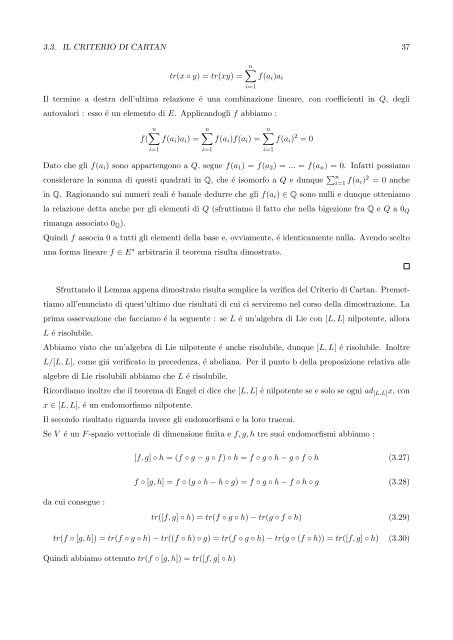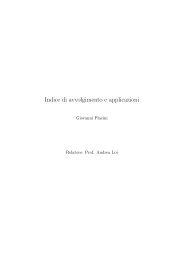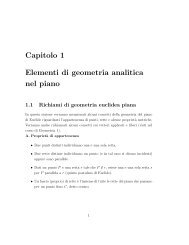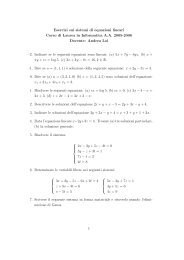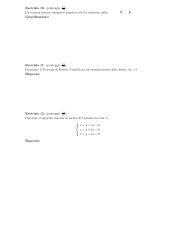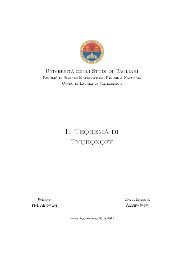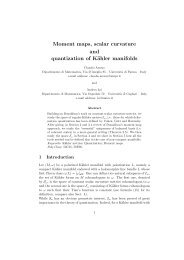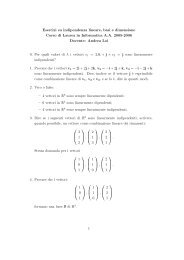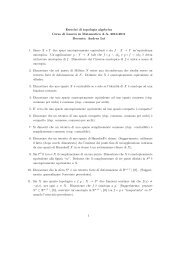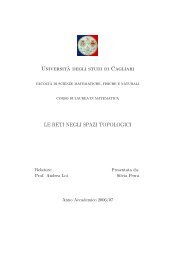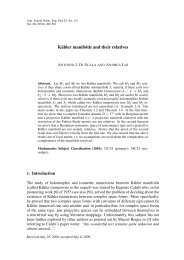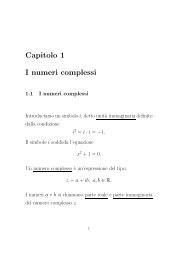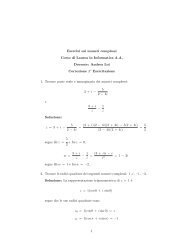Algebre di Lie semisemplici, sistemi di radici e loro classificazione
Algebre di Lie semisemplici, sistemi di radici e loro classificazione
Algebre di Lie semisemplici, sistemi di radici e loro classificazione
You also want an ePaper? Increase the reach of your titles
YUMPU automatically turns print PDFs into web optimized ePapers that Google loves.
3.3. IL CRITERIO DI CARTAN 37<br />
tr(x ◦ y) = tr(xy) =<br />
n<br />
f(ai)ai<br />
Il termine a destra dell’ultima relazione é una combinazione lineare, con coefficienti in Q, degli<br />
autovalori : esso é un elemento <strong>di</strong> E. Applicandogli f abbiamo :<br />
f(<br />
n<br />
f(ai)ai) =<br />
i=1<br />
i=1<br />
n<br />
f(ai)f(ai) =<br />
i=1<br />
n<br />
f(ai) 2 = 0<br />
Dato che gli f(ai) sono appartengono a Q, segue f(a1) = f(a2) = ... = f(an) = 0. Infatti possiamo<br />
considerare la somma <strong>di</strong> questi quadrati in Q, che é isomorfo a Q e dunque n<br />
i=1 f(ai) 2 = 0 anche<br />
in Q. Ragionando sui numeri reali é banale dedurre che gli f(ai) ∈ Q sono nulli e dunque otteniamo<br />
la relazione detta anche per gli elementi <strong>di</strong> Q (sfruttiamo il fatto che nella bigezione fra Q e Q a 0Q<br />
rimanga associato 0Q).<br />
Quin<strong>di</strong> f associa 0 a tutti gli elementi della base e, ovviamente, é identicamente nulla. Avendo scelto<br />
una forma lineare f ∈ E ∗ arbitraria il teorema risulta <strong>di</strong>mostrato.<br />
Sfruttando il Lemma appena <strong>di</strong>mostrato risulta semplice la verifica del Criterio <strong>di</strong> Cartan. Premet-<br />
tiamo all’enunciato <strong>di</strong> quest’ultimo due risultati <strong>di</strong> cui ci serviremo nel corso della <strong>di</strong>mostrazione. La<br />
prima osservazione che facciamo é la seguente : se L é un’algebra <strong>di</strong> <strong>Lie</strong> con [L, L] nilpotente, allora<br />
L é risolubile.<br />
Abbiamo visto che un’algebra <strong>di</strong> <strong>Lie</strong> nilpotente é anche risolubile, dunque [L, L] é risolubile. Inoltre<br />
L/[L, L], come giá verificato in precedenza, é abeliana. Per il punto b della proposizione relativa alle<br />
algebre <strong>di</strong> <strong>Lie</strong> risolubili abbiamo che L é risolubile.<br />
Ricor<strong>di</strong>amo inoltre che il teorema <strong>di</strong> Engel ci <strong>di</strong>ce che [L, L] é nilpotente se e solo se ogni ad [L,L]x, con<br />
x ∈ [L, L], é un endomorfismo nilpotente.<br />
Il secondo risultato riguarda invece gli endomorfismi e la <strong>loro</strong> traccai.<br />
Se V é un F -spazio vettoriale <strong>di</strong> <strong>di</strong>mensione finita e f, g, h tre suoi endomorfismi abbiamo :<br />
da cui consegue :<br />
i=1<br />
[f, g] ◦ h = (f ◦ g − g ◦ f) ◦ h = f ◦ g ◦ h − g ◦ f ◦ h (3.27)<br />
f ◦ [g, h] = f ◦ (g ◦ h − h ◦ g) = f ◦ g ◦ h − f ◦ h ◦ g (3.28)<br />
tr([f, g] ◦ h) = tr(f ◦ g ◦ h) − tr(g ◦ f ◦ h) (3.29)<br />
tr(f ◦ [g, h]) = tr(f ◦ g ◦ h) − tr((f ◦ h) ◦ g) = tr(f ◦ g ◦ h) − tr(g ◦ (f ◦ h)) = tr([f, g] ◦ h) (3.30)<br />
Quin<strong>di</strong> abbiamo ottenuto tr(f ◦ [g, h]) = tr([f, g] ◦ h)


